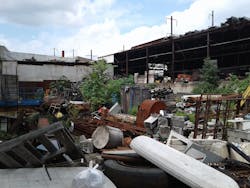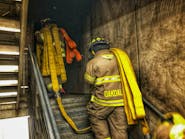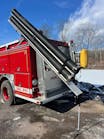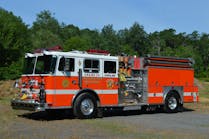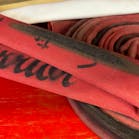The Philadelphia Fire Department (PFD) responded to multiple scrap yard fires in the summer of 2018. While each of these fires was unique, they had many issues in common.
Defining scrap yards
Scrap yard (or junk yard or salvage yard) is a term commonly used to refer to an area that businesses use to collect material for recycling or harvesting of metal or other reusable components of discarded everyday items, most commonly automobiles or general commercial property. They aren’t limited to processing cars and trucks, however, and may contain just about anything society has produced at one time or another to include wood, metal, plastic, construction debris and equipment, furniture, and liquids, such as paint, solvents, motor oil or coolant. This differentiates a scrap yard from a recycling plant, which generally processes household material purposely collected, or a dump (legal or otherwise), which would take just about anything brought in, usually for a fee. You name it and you’ll find it in a scrap yard, so when they burn, they can present daunting challenges to firefighters.
Risky business
Scrap yard fires pose many risks to firefighters.
The first hazard is the location. Scrap yards are often (but not always) found in remote or industrial parts of a jurisdiction. Most local zoning codes ensure that these operations are kept away from neighborhoods due to noise and obvious hazards, like contamination, odors and the general nature of the operation. No one wants to live next to a scrap yard. The remote locations often mean longer response times, thus allowing an undiscovered fire to gain substantial headway before firefighters arrive.
Access to the scrap yard is often the next immediate issue. Scrap yards are prone to theft, trespassing and vandalism. The owners are often creative in devising ingenious ways to secure their properties. Parking heavy equipment to block vehicle access or behind gates is my personal favorite. Retaining walls, fencing and the much-loved barbed/razor wire are also extremely common and can create challenges for firefighters trying to do their work. A breeching or extended forcible-entry operation is often required before the first drop of water can be applied to the fire.
Isolated or distant locations can lead to the next set of problems encountered—long hose stretches and limited water supply or low water pressure. Often the remote locations mean a yard will be at or near the end of the water mains. It’s important to anticipate the need for large-diameter hoseline early on, as well as possible relay pumping operations or increasing pressure in water mains. Limited vehicle access, combined with long hose stretches, means the position of first-in companies is critical. Scrap yard fires may cover large areas, commonly measured in “football fields.” Fire service drones will allow the incident commander (IC) to have a much better view of the overall scene at these types of incidents. Departments fortunate enough to have this technology have a great advantage in managing large-area incidents.
Limited access and long hose stretch, combined with heavy fire loads and enormous areas of involvement, means ruling out handlines, at least initially. Strong consideration should be given to aerial devices even if it means the first-in companies must yield space for a follow-on company with aerial capability. At a minimum, master stream devices should be employed from available safe areas as soon as possible.
Since many scrap yards come into existence when the owner erects a fence around a vacant or unused lot, contaminated runoff is a serious consideration. This lack of planning in their creation adds another dimension to the problem. ICs should alert the local water authority and even call in hazardous material crews to monitor and prevent contaminated runoff from entering sensitive waterways. Flammable runoff and even pooling may also contribute to the spread of fire into more remote areas. Firefighters must be careful not to get cut off or trapped by rapidly spreading ground fire. With your attention turned toward the main body of fire, it’s easy to miss hidden fire spreading across the ground or through piles of debris until it’s too late.
Safety considerations
Safety officers should be mandatory at scrap yard fires. Members working in and around a scrap yard must be constantly vigilant and monitored, especially near piles and rows of cars.
Often, cars are crushed, then stacked four or five high. These seemingly stable piles may shift, slide or come crashing down due to the force of master streams, the weight of water or members operating on the pile, and/or the softening of the ground due to water run-off. These fires can get extremely hot and the metal of modern cars is fairly thin. As the metal weakens, the piles are prone to shift. Extreme caution is warranted. If members absolutely must operate near cars, then strong consideration should be given to shoring them up as necessary. Narrow passages within a scrap yard are essentially confined spaces and should be treated as such.
Despite a “surround-and-drown” atmosphere, especially in the warmer months, ICs must resist the temptation to relax PPE rules. All the capabilities of PPE will be tested at one of these scenes. The smoke can be highly toxic, and even though these fires are largely “outside” fires, members operating in a suppression capacity need full SCBA. Further, the slick, wet, oil-soaked ground, along with any number of trip hazards, can mean members falling or operating off balance. Jagged metal and broken glass are an ever-present cut hazard, so gloves are a must. Master streams knocking debris around means eye protection is also must.
Night operations make for even more treacherous conditions. Illumination of the scene should be an initial consideration. Areas where members are working need to be lit not just for safe operations sake, but for supervisory reasons as well. It’s critical for safety officers and division supervisors to be able to see as much of the scene as possible. The complex and ad-hoc nature of the layout of a scrap yard means it’s extremely easy to lose track of members. Strict accountability is a must. Crews rotated for rest and rehabilitation must do so as a unit, so unit integrity is maintained. Having limited access points sometimes works in our favor, it makes tracking the movement of people into and out of the scene easier to track and manage. Frequent rotation and rehab of personnel is the key to combatting fatigue and thereby preventing injuries.
Due to the nature of the business and the types of chemicals that may be present, it’s a good idea to incorporate a hazmat component into a response if only for consultation and follow-up. At one of our recent scrap yard fires, the smoke irritated some of the residents in the area. The PFD will routinely call for air management to assist in decisions involving air quality.
Inspections and preplanning
Fire departments with scrap yards, or any other of the recycling type yards mentioned here, must take a proactive part in managing these incidents before they happen. That means inspections and preplanning should be mandatory. Ensuring that suitable access for fire department vehicles is maintained is critical. Knowing what’s contained in the yard and the exact nature of the business as well as contact information for the owner and key employees is a must. Cooperation with the building department to ensure code compliance is also strongly recommended. This ensures properties that have deficiencies can be monitored and brought into compliance.
Understanding the water supply for a given location beforehand will make or break the job. It’s also critical for calling in the right type of resources. Strong consideration should be given to the feasibility of using firefighting foam. If the operation is too large or exceeds the firefighting capacity for the jurisdiction, it may be wise to have the business covered by a yard type suppression system or maintain enough foam for firefighting operations on the premises.
Recent response
On Aug. 28, 2018, at 6:24 a.m., box 2418 Front Street and Lehigh Avenue was struck out with an address of fire not given. The report was for “smoke in the area.” The PFD responded with initial-arriving units reporting “nothing showing,” however, an odor of smoke was present in the area. Upon further investigation, companies made their way to a property located at Front and West Venango streets, where they encountered a commercial property with a two-story wall surrounding it. The property backed up to active railroad tracks in the rear with commercial/industrial buildings on either side. Access was thereby limited to the Venango Street side. Crews had no choice but to make forcible entry through a large steel door.
Once inside they encountered a haze of smoke and piles of debris of every description. The property was a storage yard for a demolition/scrap business. The owner deposited the refuse from demolition work at the property where crews would cut, chop and store or resell anything of value. The leftovers were discarded or left to rot in piles, some as high as two stories.
Inside the property was a building where the fire was located. This building was approximately 100 feet from the entrance to the yard. Due to its construction, it was determined that this building most likely was part of the railroad infrastructure at one time. It was rectangularly shaped, concrete and heavy reinforced masonry, windowless, approximately 40 feet deep and 300 feet long. The only visible opening was a steel roll-up door that needed to be breeched in order to gain entry.
With vehicle access limited, firefighters were forced to weave their way through the junk, dragging the hoseline. Once inside this windowless structure, they encountered little heat but dense, heavy smoke. Local vandals had breeched an outer wall on the railroad side of the property to gain entry. This building was packed with all manner of combustible junk. The immediate problem for the fire crews was the near complete lack of access points to put hose streams on the seat of the fire. Complicating matters was zero visibility and difficulty just walking through the structure.
After a cautious, extended operation, firefighters managed to breech the walls in other spots to effect ventilation. Multiple fires were extinguished, and no serious damage was done. The building codes department (Philadelphia Department of Licenses and Inspections) was summoned and civil processes were ongoing against the owner of the property. It could have been much worse.
In sum
Scrap yard fires usually pose little threat to life or property. They are the final stop for much of the world’s waste and should be treated accordingly, little more than surround-and-drown operations. A thoughtful, careful, methodical approach should be taken and a rigorous risk vs. gain assessment process should continue throughout the entire job. Firefighters should never get injured trying to save trash or junk. Even so, scrap yard fires still require a great deal of caution and vigilance and shouldn’t be taken likely. In these properties, it’s the unknown hazards that can catch you off guard. Stay safe.
